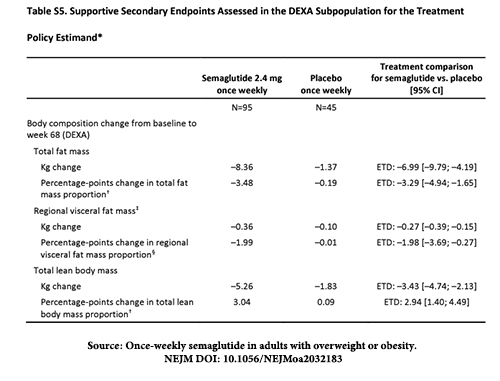In 2021, I highlighted the impact of rapid weight loss programs on your basal metabolic rates (BMR) and your ability to sustain any intense exercise activity, which directly applies to the current rabid interest in new weight loss meds. Fat mass does not simply evaporate, it must be utilized as an energy source, and for the most part, it will come from its use by muscle tissue, which requires a tad more effort than playing blitz chess or channel surfing with your TV remote. Semaglutide, the active ingredient in both meds, isn’t going to miraculously vaporize your unwanted fat. It may reduce your appetite to anorexic levels, but what are the possible consequences of the two things you need for long-term weight control - sufficient muscle mass and normal basal metabolic rate?
Muscle Mass
 Recently, STAT pointed out that a large clinical trial of Wegovy over 17 months demonstrated that the 95 participants did have a significant loss in total body weight as measured by dual-energy x-ray absorptiometry (DEXA) - the most accurate way of assessing body composition, However, nearly 40% of the reduction was lean mass, which would be muscle and water weight. This supplementary table from the New England Journal of Medicine demonstrates that of the 95 participants measured with DEXA, there was an 8.36 kg total fat loss but a 5.26 kg loss in lean mass as well. So, what are the ramifications of this long-term?
Recently, STAT pointed out that a large clinical trial of Wegovy over 17 months demonstrated that the 95 participants did have a significant loss in total body weight as measured by dual-energy x-ray absorptiometry (DEXA) - the most accurate way of assessing body composition, However, nearly 40% of the reduction was lean mass, which would be muscle and water weight. This supplementary table from the New England Journal of Medicine demonstrates that of the 95 participants measured with DEXA, there was an 8.36 kg total fat loss but a 5.26 kg loss in lean mass as well. So, what are the ramifications of this long-term?
If the caloric content is too low, especially the carbohydrates, liver, and muscle tissue glycogen stores will be significantly reduced. Keep in mind that the average sedentary person retains about 600 grams, or roughly 1.3 pounds, of stored glycogen, which is accompanied by a 3:1 ratio of water, or 3 pounds of water for a pound of glycogen. When you lose the glycogen on any low-calorie or high-protein diet, you lose water as well, resulting in some dramatic initial weight loss unrelated to fat mass. The glycogen loss also prompts the liver to begin a series of complex reactions to synthesize the needed energy substrate the brain, muscle, red blood cells, etc., require as an energy source. The substrate for these reactions will come from muscle tissue protein strands, not fat mass, regardless of the adaptation to increased fatty acid use from fat cells, which is the crux of the reasoning behind using these meds for weight loss.
How much muscle mass will be catabolized to accommodate the significant reduction in calories in conjunction with what is assumed to be increased activity levels needed for these drugs to be effective? The STAT article has already provided the answer. It appears that for every pound of fat loss using Semiglutide, you may end up losing just shy of a half-pound of lean mass. Now whether this is true for each individual using these meds is unknown, but the question remains, are you crippling your ability to maintain the weight loss long-term with these meds if this much muscle wasting is occurring?
Muscle tissue is roughly 75% water by weight and 22% protein or amino acids. So, one pound of muscle (454 grams) contains approximately 100 grams of amino acids. If the liver could catabolize and use these amino acids as an energy source, with no energy lost in the process, which is not realistic, there would be roughly 400 calories available as an energy source for every pound of muscle tissue lost. The level of self-imposed energy deficit, reduced eating, and the medicines’ reduction of appetite will dictate the degree of muscle wasting that occurs. This issue should be managed closely to prevent the precipitation or exacerbation of the loss of much-needed muscle tissue.
Basal Metabolic Rate (BMR)
The negative impact on the BMR long-term could be significant. Even a small reduction of just 100 calories per day in your BMR is substantial - 10 pounds of fat mass over the course of a year. [1] This is all theoretical, but it illustrates that your course of action for sustainable weight loss should be a thoughtful consideration before you pursue it. There is definitely a population of individuals who will obtain significant benefits from these products. And plenty of eager candidates want a painless injection instead of spending time in the gym. But these meds are not the solution to obesity; early intervention is.
[1] Burning 100 calories fewer per day at rest, times 365 days (one year), equals 36,500 calories. Divided by the 3500 calories in one pound of fat, and you come up with 10 pounds




